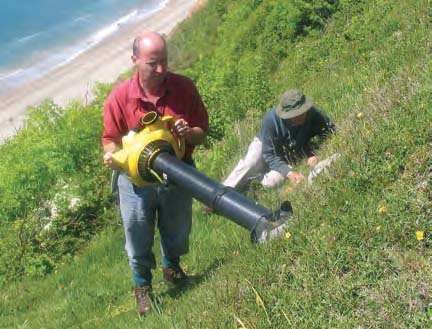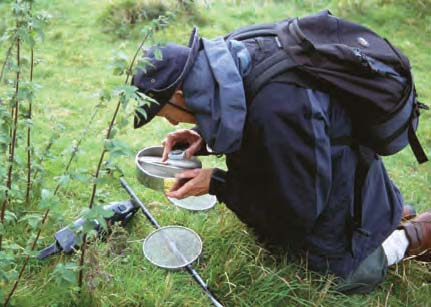|
In April 2006 my attention was drawn to a survey conducted in 1999 by the National Trust on invertebrate populations in coastal Co. Durham (vice-county 66). Sampling was carried out using a large vacuum blower of the type used commercially for tidying away autumn leaves, modified by fastening an insect net to the mouth of the leaf blower to collect the invertebrates. During this survey live specimens of the tiny vertiginid snail Truncatellina cylindrica were found. This snail had not been seen in this area for over 150 years (Alder 1848), but that may be none too surprising since it is small enough to be easily overlooked. Since I had planned to visit the area concerned, I went with a colleague to the locality in early June 2006 to investigate what this animal’s habitat looked like and discover how findable it was. We spent a couple of hours hand searching the site for snails, and found nothing. I had been wondering for some time whether vacuum sampling might be the solution to finding such elusive animals; but leaf blowers are something like five feet long, heavy, expensive, and since they run on petrol, noisy and a fire hazard. Southwood (1975) states that you need a nozzle velocity of over sixty miles an hour for adequate vacuum sampling; portable equipment such as a battery operated car vacuum will not achieve that ... or will it? A trip to the local DIY store revealed that some of the newer designs of battery operated vacuum cleaners come with crevice nozzles. I purchased one costing less than £10 which was small enough to fit into my usual field bag, and after charging the batteries took it along to the field meeting at Stanford Reservoir on the Leicestershire/Northamptonshire border on 8 July. The first habitat I tested it on was the side of a deep drainage ditch with long grass. The catch contained no snails but did have a varied assemblage of leaf hoppers and springtails many of which were of species that I had not seen before. The next habitat was of waterlogged sedges next to the reservoir where there would have been a constant water table. This sample contained eight Vertigo substriata and one Vertigo antivertigo. It worked! Samples from short grassland turf on Bredon Hill on 30 September contained Trochulus hispidus a.k.a. Trichia hispida and nothing else. We made a rapid visit to the Co. Durham site in early July 2007, where a single vacuum sample produced one T. cylindrica, 2 Vertigo pygmaea, a dead shell of Vitrea contracta and 9 juvenile Candidula intersecta. The vacuum was most recently tested on the Middle Marsh at Dinton Pastures on 14 July 2007 when Cochlicopa lubrica and Vertigo antivertigo were found. My conclusion is that small battery operated vacuum cleaners are a useful adjunct to hand searching for finding small molluscs and other invertebrates in vegetation. The machine I am using is a Dust Devil DD038 which is 13.9 in/36 cm long, but other makes may prove equally suitable. The dust filter in this machine is of brushed cotton and needs to be turned inside-out so that the brushed surfaces do not face the sample. The crevice nozzle may occasionally become blocked so some means of cleaning it needs to be carried or improvised. References Alder, J (1848) A catalogue of the Mollusca of Northumberland and Durham. Transactions of the Tyneside Naturalists’ Field Club 1: 97-209 [on p. 134]. Southwood, TRE (1975) Ecological methods with particular reference to the study of insect populations. London: Chapman and Hall |
|
Using a battery operated vacuum cleaner for sampling small invertebrates
Issue
15
Page
8

 Fig.1. Commercial leaf blower being used for snail sampling Photo: Ron Boyce
Fig.1. Commercial leaf blower being used for snail sampling Photo: Ron Boyce Fig. 2. Battery operated vacuum cleaner being used for snail sampling Photo: Rosemary Hill
Fig. 2. Battery operated vacuum cleaner being used for snail sampling Photo: Rosemary Hill